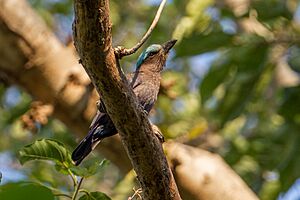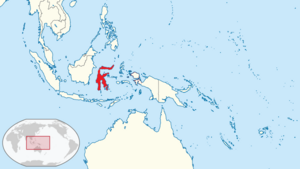Purple-winged roller facts for kids
Quick facts for kids Purple-winged roller |
|
|---|---|
 |
|
| Conservation status | |
| Scientific classification | |
| Genus: |
Coracias
|
| Species: |
temminckii
|
 |
|
| Synonyms | |
|
|
The purple-winged roller (Coracias temminckii) is a beautiful bird that belongs to the Coraciidae family. These birds are special because they are endemic to a specific area. This means they are only found in the Sulawesi region of Indonesia. You can spot them on islands like Sulawesi, Bangka, Lembeh, Manterawu, Muna, and Butung.
These rollers love to live in warm, wet lowland forests. This is their natural habitat.
About the Purple-Winged Roller
What's in a Name?
The purple-winged roller was first officially described in 1819. A French bird expert named Louis Pierre Vieillot gave it the scientific name Garrulus temminckii. The second part of its name, temminckii, was chosen to honor another famous bird expert, Coenraad Jacob Temminck from the Netherlands.
This bird's original home, or "type locality," is the island of Sulawesi. Today, the purple-winged roller is one of nine species in the Coracias group. This group was first named by Carl Linnaeus way back in 1758.
Scientists have studied the DNA of these birds. In 2018, they found that the purple-winged roller is most closely related to the Indochinese roller.
The phylogenetic relationships among the Coracias species are shown below, from the molecular study by Johansson et al. (2018)
| Coracias |
|
||||||||||||||||||||||||||||||||||||||||||||||||
People sometimes call the purple-winged roller by other names. These include the Celebes roller, Sulawesi roller, and Temminck's roller.
What Does It Look Like?
The purple-winged roller is about 30 to 34 centimeters (12 to 13.5 inches) long. This is about the same size as a Eurasian jay.
This bird has a very colorful look:
- Its head (cap) and the feathers above its tail are a bright, sky-blue color.
- Its back is a dark olive green.
- The rest of its body feathers are mostly a deep, dark blue.
- It has a large, black beak.
Both male and female purple-winged rollers look the same. Young rollers, called juveniles, look a lot like the adults. However, their colors are a bit duller.
Images for kids



